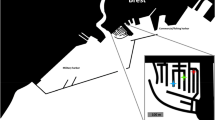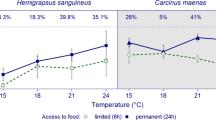Abstract
Ascidian densities were manipulated while controlling for negative effects of biodeposition and space preemption to examine the effects of ascidian filter-feeding on larval recruitment in St. Joseph Bay and near Turkey Point, Florida (Northern Gulf of Mexico, Florida, USA). Using three different experimental designs during 1984 and 1985, recruitment near living Styela plicata or Molgula occidentalis was as high as recruitment near ascidian models. Disruption of flow by ascidian bodies had little effect on settlement. Predation rates by ascidians on larvae in six phyla were high in laboratory experiments. The field effects of larval depletion by solitary ascidians are apparently obscured by other factors influencing the abundance of recruiting larvae. Consumption of larvae in the laboratory cannot be used to assume significant inhibitory effects in the field.
Similar content being viewed by others
Literature cited
Best, B. (1978). The effects of suspension feeding by the bivalve, Mercenaria mercenaria, on community structure. M.S. thesis, University of Florida
Bingham, B. L., Walters, L. J. (1989). Solitary ascidians as predators of invertebrate larvae: evidence from gut analyses and plankton samples. J. exp. mar. Biol. Ecol. (in press)
Black, R., Peterson, C. H. (1988). Absence of preemption and interference competition for space between large suspension-feeding bivalves and smaller infaunal macroinvertebrates. J. exp. mar. Biol. Ecol. 120: 183–198
Bros, W. E. (1987). Effects of removing or adding structure (barnacle shells) on recruitment to a fouling community in Tampa Bay, Florida. J. exp. mar. Biol. Ecol. 105: 275–296
Butman, C. A. (1987). Larval settlement of soft-sediment invertebrates: the spatial scales of pattern explained by active habitat selection and the emerging role of hydrodynamical processes. Oceanogr. mar. Biol. A. Rev. 25: 113–165
Checkley, D. M., Jr. (1980). The egg production of a marine planktonic copepod in relation to its food supply: laboratory studies. Limnol. Oceanogr. 25: 430–436
Cohen, J. (1977). Statistical power analysis for the behavioral sciences. Academic Press, New York and London
Commito, J. A. (1987). Adult-larval interactions: predictions, mussels and cocoons. Estuar. cstl Shelf Sci. 25: 599–606
Connell, J. H. (1985). The consequences of variation in initial settlement vs. post-settlement mortality in rocky intertidal communities. J. exp. mar. Biol. Ecol. 93: 11–45
Connell, J. H., Keough, M. J. (1985). Disturbance and patch dynamics of subtidal marine animals on hard substrata. In: Pickett, S. T., White, P. S. (eds.) The ecology of natural disturbance and patch dynamics. Academic Press, New York and London, p. 125–151
Cowden, C., Young, C. M., Chia, F. S. (1984). Differential predation oa marine invertebrate larvae by two benthic predators. Mar. Ecol. Prog. Ser. 14: 145–149
Dagg, M. J., Gill, D. W. (1980). Natural feeding rates of Centropages typicus females in the New York Bight. Limnol. Oceanogr. 25: 597–609
Dean, T. A. (1981). Structural aspects of sessile invertebrates as organizing forces in an estuarine fouling community. J. exp. mar. Biol. Ecol. 53: 163–180
Dean, T. A., Hurd, L. E. (1980). Development in an estuarine fouling community: the influence of early colonists on late arrivals. Oecologia 46: 295–301
Doherty, P. J., Sale, P. F. (1985). Predation on juvenile coral reef fishes: an exclusion experiment. Coral Reefs 4: 225–234
Ertman, S. C., Jumars, P. A. (1988). Effects of bivalve siphonal currents on the settlement of inert particles and larvae. J. mar. Res. 46: 797–813
Fiala-Médioni, A. (1978a). Filter-feeding ethology of benthic invertebrates (ascidians). III. Recording of water current in situ-rate and rhythm of pumping. Mar. Biol. 45: 185–190
Fiala-Médioni, A. (1978b). Filter-feeding ethology of benthic invertebrates (ascidians). IV. Pumping rate, filtration rate, filtration efficiency. Mar. Biol. 48: 243–249
Fiala-Médioni, A. (1978c). Filter-feeding ethology of benthic invertebrates (ascidians). V. Influence of temperature on pumping, filtration and digestion rates and rhythms in Phallusia mamillata. Mar. Biol. 48: 251–259
Fiala-Médioni, A. (1979a). Influence de la concentration algale du milieu sur le pompage, la filtration et l'absorption de Phallusia mammillata (Cuvier, 1815) (ascidie simple). Annls Inst. océanogr., Paris (N.S.) 55: 155–162
Fiala-Médioni, A. (1979b). Effects of oxygen tension on pumping, filtration and oxygen uptake in the ascidian Phallusia mammillata. Mar. Ecol. Prog. Ser. 1: 49–53
Fisher, T. R. (1977). Metabolic maintenance costs of the suspension feeder Styela plicata. Mar. Biol. 41: 361–369
Gaines, S., Brown, S., Roughgarden, J. (1985). Spatial variation in larval concentrations as a cause of spatial variation in settlement for the barnacle, Balanus glandula. Oecologia 67: 267–272
gaines, S., Roughgarden, J. (1985). Larval settlement rate: a leading determinant of structure in an ecological community of the marine intertidal zone. Proc. natn. Acad Sci. U.S.A. 82: 3707–3711
Gifford, D. J., Bohrer, R. N., Boyd, C. M. (1981). Spines on diatoms: do copepods care? Limnol. Oceanogr. 26: 1057–1061
Goodbody, I. (1961). Inhibition of the development of a marine sessile community. Nature, Lond. 190: 282–283
Hecht, S. (1918). The physiology of Ascidia atra Lesueur II. Sensory physiology. J. exp. Zool. 25: 261–299
Hunt, J. H., Ambrose, W. G., Jr., Peterson, C. H. (1987). Effects of the gastropod, Illyanassa obsoleta (Say), and the bivalve, Mercenaria mercenaria (L.), on larval settlement and juvenile recruitment of infauna. J. exp. mar. Biol. Ecol. 108: 229–240
Jackson, J. B. C. (1977). Competition on marine hard substrata: the adaptive significance of solitary and colonial strategies. Am. Nat. 111: 743–767
Jackson, J. B. C. (1983). Biological determinants of present and past sessile animal distributions. In: Tvesz, M. J. S., McCail, P. L. (eds.) Biotic interactions in recent and fossil benthic communities. Plenum Press, New York and London, p. 39–120
Jørgensen, C. B. (1955). Quantitative aspects of filter feeding in invertebrates. Biol. Rev. 30: 391–454
Jørgensen, C. B., Goldberg, E. D. (1953). Particle filtration in some ascidians and lamellibranchs. Biol. Bull. mar. biol. Lab., Woods Hole 105: 477–489
Keough, M. J. (1983). Patterns of recruitment of sessile invertebrates in two subtidal habitats. J. exp. mar. Biol. Ecol. 66: 213–245
Klump, D. W. (1984). Nutritional ecology of the ascidian Pyura stolonifera: influence of body size, food quantity and quality on filter-feeding, respiration, assimilation efficiency and energy balance. Mar. Ecol. Prog. Ser. 19: 269–284
Landry, R. M. (1980). Detection of prey by Calanus pacificus: implications of the first antennae. Limnol. Oceanogr. 25: 545–549
Mattson, S. A. (1987). The impact of predation on species richness and percent cover of epifauna after recruitment to cockle shells. M.S. thesis, Florida State University
McGinitie, G. E. (1939). The method of feeding of tunicates. Biol. Bull. mar. biol. Lab., Woods Hole 77: 443–447
Osman, R. W. (1977). The establishment and development of a marine epifaunal community. Ecol. Monogr. 47: 37–63
Peterson, C. H. (1982). The importance of predation and intra- and interspecific competition in the population biology of two infaunal suspension-feeding bivalves, Protothaca staminea and Chione undatella. Ecol. Monogr. 52: 437–475
Randlov, A., Riisgård, H. U. (1979). Efficiency of particle retention and filtration rate in four species of ascidians. Mar. Ecol. Prog. Ser. 1: 55–59
Robbins, I. J. (1983). The effects of body size, temperature, and suspension feeding density on the filtration and ingestion of inorganic particulate suspensions by ascidians. J. exp. mar. Biol. Ecol. 70: 65–78
Rumrill, S. S., Pennington, J. T., Chia, F. S. (1985). Differential susceptibility of marine invertebrate larvae: laboratory predation of sand dollar, Dendraster excentricus (Eschscholtz), embryos and larvae by zoeae of the red crab, Cancer productus Randall. J. exp. mar. Biol. Ecol. 90: 193–208
Singarajah, K. V. (1969). Escape reactions of zooplankton: the avoidance of a pursuing siphon tube. J. exp. mar. Biol. Ecol. 3: 171–178
Sutherland, J. P. (1974). Multiple stable points in natural communities. Am. Nat. 108: 859–873
Sutherland, J. P. (1978). Functional roles of Schizoporella and Styela in the fouling community at Beaufort, North Carolina. Ecology 59: 257–264
Thorson, G. (1950). Reproduction and larval ecology of marine bottom invertebrates. Biol. Rev. 25: 1–45
Underwood, A. J. (1981). Techniques of analysis of variance in experimental marine biology and ecology. Oceanogr. mar. Biol. A. Rev. 19: 513–605
Underwood, A. J., Denley, E. J. (1984). Paradigms, explanations and generalizations in models for the structure of intertidal communities on rocky shores. In: Strong, D., Simberloff, D., Abele, L. G., Thistle, A. B. (eds.) Ecological communities: conceptual issues and the evidence. Princeton University Press, Princeton, p. 151–180
Williams, J. G. (1980). The influence of adults on the settlement of spat of the clam, Tapes japonica. J. mar. Res. 38: 729–741
Woodin, S. A. (1976). Adult-larval interactions in dense infaunal assemblages: patterns of abundance. J. mar. Res. 34: 25–41
Yen, J. (1982). Sources of variability in attack rates of Euchaeata elongata Esterly, a carnivorous marine copepod. J. exp. mar. Biol. Ecol. 63: 105–117
Young, C. M. (1988). Ascidian cannibalism correlates with larval behavior and adult distribution. J. exp. mar. Biol. Ecol. 117: 9–26
Young, C. M., Braithwaite, L. F. (1980). Orientation and current-induced flow in the stalked ascidian Styela montereyensis. Biol. Bull. mar. biol. Lab., Woods Hole 159: 428–440
Young, C. M., Chia, F. S. (1987). Abundance and distribution of pelagic larvae as influenced by predation, behavior, and hydrographic factors. In: Giese, A. C., Pearse, J. S., Pearse, V. B. (eds.) Reproduction of marine invertebrates. Vol. 9. General aspects: seeking unity in diversity. Blackwell, Palo Alto, and Boxwood Press, Pacific Grove, p. 385–463
Young, C. M., Gotelli, N. J. (1988). Larval predation by barnacles: effects on patch colonization in a shallow subtidal community. Ecology 69: 624–634
Author information
Authors and Affiliations
Additional information
Communicated by J. M. Lawrence, Tampa
Rights and permissions
About this article
Cite this article
Young, C.M. Larval depletion by ascidians has little effect on settlement of epifauna. Mar. Biol. 102, 481–489 (1989). https://doi.org/10.1007/BF00438349
Accepted:
Issue Date:
DOI: https://doi.org/10.1007/BF00438349




